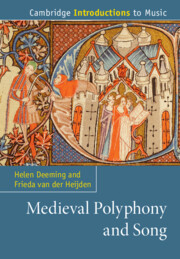Book contents
- Cambridge Introductions to Music
- Medieval Polyphony and Song
- Copyright page
- Dedication
- Contents
- Figures
- Tables
- Boxes
- Music Examples
- Acknowledgements
- Chapter 1 Introduction and Historical Outline
- Chapter 2 Monastic Centres in the Early Middle Ages
- Chapter 3 Court and Cloister in Aquitaine and Occitania
- Chapter 4 Paris: City, Cathedral, and University
- Chapter 5 Courts and Cities in Northern France
- Chapter 6 Scribes, Scholars, and Secretaries in Fourteenth-Century France
- Chapter 7 England after the Norman Conquest
- Chapter 8 On the Shores of the Mediterranean: Italy, Sicily, and the Iberian Peninsula
- Chapter 9 The German- and Dutch-Speaking Lands
- Chapter 10 Medievalisms: Modern Encounters with Medieval Polyphony and Song
- Glossary
- Bibliography
- Discography
- Index
- Cambridge Introductions to Music
- References
Chapter 8 - On the Shores of the Mediterranean: Italy, Sicily, and the Iberian Peninsula
Published online by Cambridge University Press: 27 April 2023
- Cambridge Introductions to Music
- Medieval Polyphony and Song
- Copyright page
- Dedication
- Contents
- Figures
- Tables
- Boxes
- Music Examples
- Acknowledgements
- Chapter 1 Introduction and Historical Outline
- Chapter 2 Monastic Centres in the Early Middle Ages
- Chapter 3 Court and Cloister in Aquitaine and Occitania
- Chapter 4 Paris: City, Cathedral, and University
- Chapter 5 Courts and Cities in Northern France
- Chapter 6 Scribes, Scholars, and Secretaries in Fourteenth-Century France
- Chapter 7 England after the Norman Conquest
- Chapter 8 On the Shores of the Mediterranean: Italy, Sicily, and the Iberian Peninsula
- Chapter 9 The German- and Dutch-Speaking Lands
- Chapter 10 Medievalisms: Modern Encounters with Medieval Polyphony and Song
- Glossary
- Bibliography
- Discography
- Index
- Cambridge Introductions to Music
- References
Summary
Between the twelfth and the fourteenth century, the Mediterranean Sea facilitated cultural exchange with profound effects on music. Chapter 8 witnesses the interaction of artists and musicians from Muslim, Jewish, and Christian traditions in Mediterranean locations such as Sicily and Iberia (now Spain and Portugal). We look at the cultural backdrop to the Cantigas de Santa Maria compiled at the court of Alfonso X of Castile-León, observing influences from Arabic and Hebrew poetry as well as Occitan and French song. Pilgrimage was another facilitator of travel and exchange, and repertories of polyphony and song from the pilgrimage sites of Santiago de Compostela and Montserrat point to the musical sounds that accompanied these journeys. A practical singing exercise offers readers a taste of the pilgrimage experience, by singing one of the songs provided for the rowdy pilgrims at Montserrat. In Italy, new religious movements inspired by St Francis of Assisi generated vernacular devotional songs in the form of the lauda, and in the fourteenth century - the era of Dante and Petrarch - the use of the Italian language for literature and song became paramount.
Keywords
- Type
- Chapter
- Information
- Medieval Polyphony and Song , pp. 160 - 180Publisher: Cambridge University PressPrint publication year: 2023

